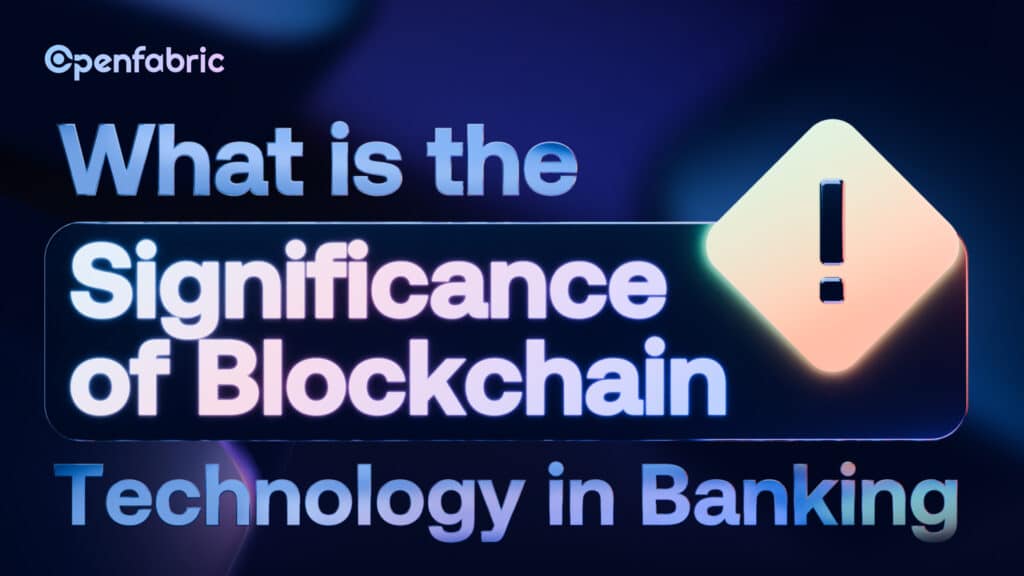
July 16, 2024 8 minutes read
What is the Significance of Blockchain Technology in Banking?

In the early 90s, two scientists named Stuart Haber and W. Scott Stornetta first introduced the idea of blockchain technology. What they wanted was a technology that cryptographically stores the details of a digital document to avoid misdating. This system stored the details of these documents in a chain of blocks. This formed the basic principle behind blockchain and the application of blockchain technology in banking.
Further down the years various cryptographic innovators and activists such as Hal Finney and Satoshi Nakamoto contributed to the history of blockchain. For example, between 2008 and 2009, Satoshi Nakamoto formed the concept of ‘Distributed Blockchain,’ which was later applied with the release of Bitcoin.
All this while, blockchain technology didn’t quite find its way into the financial market. However, after realizing the potential of blockchain technology financial industries moved from digital currencies to blockchain development. This has nudged forward the application of blockchain in financial industries like banks.
Blockchain technology has not yet seen an extensive application in the modern banking system. But that is set to change soon with a greater evolution of blockchain technology. The head of digital assets at Goldman Sachs, Mathew McDermott, revealed that in about five to 10 years, “you could see a financial system where all assets and liabilities are native to a blockchain, with all transactions natively happening on chain”.
Challenges Faced by The Banking Sector Today
The banking industry has served for many years. In these years, they have made changes to keep the banking system working. Despite these changes, there are still flaws in the banking system that pose challenges especially for their customers.
These challenges include:
Slow transaction processing
In a bid to reduce fraud, banks do not allow automatic transactions. Therefore, before approving and settling transactions, a series of checks must be done. This slows down transaction speed.
A lot of these processes involve paperwork and intermediaries to verify and connect with the receiving account. This method is archaic, clumsy and costs a lot more. At the end of the day, customers spend more time and money on transactions.
In addition, natural and environmental disturbances affect bank transactions.. For example, because of extreme weather conditions, bank transactions may not be processed on time.
Targets of hackers
Traditional banking processes are huge targets of hackers. There are flaws in their designs attempting at verifying users’ identities. Therefore, there are cases of identity thefts and stealing of funds from people’s accounts. Examples of banking thefts common are credit card frauds, phishing, wire frauds, or even total account takeovers.
These frauds are typically hard to trace and as a result victims may permanently lose their money.
In addition, human error and technical glitches affect traditional banking processes This makes the entire process unsafe.
Limited opportunities for growth
Let us consider trading and stock exchange using traditional banking processes. A typical stock exchange process involves a lot of stages and bureaucracy which takes a few days at least. The number of intermediaries involved in the process causes this result. This kind of trading does not encourage financial growth.
Also, in this digital age, we cannot apply traditional banking methods everywhere. When they are, they are more expensive due to the costs incurred making the transactions.
On a general level, the slowness and the high cost of transactions in banking limits a lot of opportunities for growth.
Limitations in peer-to-peer banking
Peer-to-peer transactions in traditional banking are generally cumbersome and slow. Furthermore, geographical borders limit it, and resolving this is expensive. Due to the constraints in peer-to-peer banking, users can only buy from or sell to others within a geographical location.
Advantages of Blockchain Technology in Banking
Faster transaction processing
Transaction processing on a blockchain network is fast. In addition to being fast, it is cheaper than traditional banking.
By implementing blockchain technology in banking, we can significantly reduce the time it takes to process transactions and lower the cost of processing them. This will cut off the intermediaries involved in these transactions and improve the quality of banking services.
In addition, we will encourage businesses to bring in newer products into the digital market.
Better security protocols
Blockchain technologies have security protocols to prevent fraud and theft. In one instance, blockchain technology limits the number of people involved in transactions. The parties involved in a transaction keep the records of payments and transactions directly, and there is no intermediary.
The introduction of blockchain technology in banking will greatly reduce the number of frauds common in traditional banking. By limiting the number of parties involved, there is a simultaneous reduction of single points of failure.
Finally, you can store the records of the transactions digitally on the chain for security.
Vast opportunities for growth
There are no limitations with blockchain. Moreover, borders or physical and environmental disturbances do not hinder it.
Blockchain technology opens up a wide range of opportunities such as:
- Peer-to-peer transactions
- Acquisition of digital assets
- Better trading
- Fundraising and so on
Furthermore, the reduced costs of transactions will encourage producers to bring more of their products into the digital market. This will cause an evolutionary change in the digital market.
Improved accuracy
Blockchain technology is not subject to human error unlike traditional banking methods. Implementing blockchain technology in banking will greatly improve the accuracy and efficiency of transactions. Thus, there will be a reduction in the risk of customers losing money.
Improved customer service
This is an overall advantage of blockchain technology in banking. When customers feel assured of the safety of their money and private data, it creates a sense of satisfaction.
Also, customers will find the transaction process better with the faster speed and reduced costs.
Use cases of blockchain technology in banking
Trading and stock exchange
As earlier stated, traditional trading and stock exchange involves a lot of stages and intermediaries like the stock exchange. Using blockchain removes these stages and intermediaries. Instead, computers all over the world automate these processes.
Currently, Decentralized Finance (DeFi) is already being used for trading. This decentralized technology enables a faster trading process between traders outside of the blockchain. The blockchain can then store the final record of the transactions for security. Therefore, eliminating the need for intermediaries.
International transactions
The Society for Worldwide Interbank Financial Telecommunications (SWIFT) currently handles international transactions. They are intermediaries that connect member banks involved in an international transaction. Therefore, there is sharing of data between them and the banks.
Blockchain technology connects buyers and sellers directly to each other. Eliminating the need for intermediaries. The entire buying and selling process is faster and more secure. Users store their private data only on the blockchain digitally.
Some institutions are already implementing blockchain for this purpose. The US Federal Reserve implemented IBM’s Financial Transaction Manager to improve its automated clearing house (ACH) processing platform. This happened in 2016. The result of this is a cost efficient transaction fee and faster processing.
Lending and borrowing
Here again, DeFi is applied. Typically, lenders and borrowers are connected directly with one another. This is the concept of peer-to-peer lending and borrowing. The overall result is an improvement in the time needed to borrow.
Blockchain also safeguards the process of lending and borrowing. It ensures that only eligible and verified users on the blockchain network can borrow or lend money. Through its verification procedures, it provides security by eliminating the risks of loan frauds.
Digital Identity Verification
Blockchain technology improves the verification of users’ identities currently used.
Typically, banks use know-your-customer (KYC) and Anti-Money Laundering (AML) processes to verify the identity of users. This is a good method, the drawback is these methods have to be done for every financial service provider.
Meanwhile in blockchain, the process of verification is done once and can be reused over and over again.
Openfabric’s involvement in blockchain technology in banking
As a layer 1 blockchain technology, we have developed tools that could be used extensively in banking. Here is how the involvement of Openfabric’s blockchain technology in banking could revolutionize the sector
- Using cryptography to enhance the security of transactions.
- Utilization of blockchain technology to ensure accuracy of transactions.
- Buying and selling of digital assets using Openfabric technology.
- Improving verification of users’ with smart, intelligent AI.
Without the appropriate tools, it may be difficult to carry out all these activities. Here are some tools and features we have developed to use for your banking processes:
- Openfabric Crypto trading bot: an AI powered bot designed to help you in the cryptocurrency market. With additional functions such as analyzing the market and a testnet feature this bot helps to minimize risk.
- Openfabric marketplace: this feature connects buyers and sellers. It is a decentralized marketplace where users can purchase and sell digital assets. It connects buyers and sellers directly, enabling peer-to-peer transactions.
- Integration with MetaMask: the Openfabric AI platform allows you to register with your existing MetaMask account. Using the verification from your MetaMask account, you can explore the Openfabric AI platform widely.
The MetaMask account allows you to authenticate transactions, and handles payments seamlessly and securely.
Visit our website to see more on the Openfabric AI platform.
Conclusion
The banking sector, although a giant in the finance industry, is slow to adapt to modern banking methods especially in the use of blockchain. With the application of blockchain technology in banking, these challenges can be removed to generally improve customer service.
Finally, blockchain technology accurately matches the era we are in. Where everyone is on the lookout for a faster and cheaper way to do almost everything. This shows that with time, there will be a broader implantation of blockchain technology in banking creating an improved banking experience for everyone.
Openfabric is helping to make this a reality and bringing the era of total integration of blockchain technology in banking closer. So that when that time comes, we will be the cornerstone to provide blockchain technology in the banking industry.

